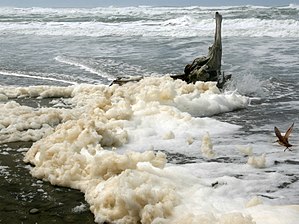
Sea foam, ocean foam, beach foam, or spume is a type of foam created by the agitation of seawater, particularly when it contains higher concentrations of dissolved organic matter (including proteins, lignins, and lipids) derived from sources such as the offshore breakdown of algal blooms.[1] These compounds can act as surfactants or foaming agents. As the seawater is churned by breaking waves in the surf zone adjacent to the shore, the surfactants under these turbulent conditions trap air, forming persistent bubbles that stick to each other through surface tension.
Sea foam is a global phenomenon,[1] and it varies depending on location and the potential influence of the surrounding marine, freshwater, and/or terrestrial environments.[2] Due to its low density and persistence, foam can be blown by strong on-shore winds inland, towards the beach. Human activities, such as production, transport or spillage of petroleum products or detergents, can also contribute to the formation of sea foam.
- ^ a b Schilling, Katerina; Zessner, Matthias (1 October 2011). "Foam in the aquatic environment". Water Research. 45 (15): 4355–4366. Bibcode:2011WatRe..45.4355S. doi:10.1016/j.watres.2011.06.004. ISSN 0043-1354. PMID 21757217.
- ^ HAROLD, E.; SCHLICHTING, JR. (1971). "A Preliminary Study of the Algae and Protozoa in Seafoam". Botanica Marina. 14 (1). doi:10.1515/botm.1971.14.1.24. ISSN 0006-8055. S2CID 84135769.